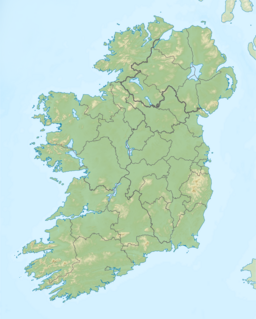Loch Na Fooey (Irish: Loch na Fuaiche, meaning "lake of the fissure"),[2] also Loch Nafooey or Lough Nafooey, is a rectangular shaped glacial lake in County Galway, Ireland. Part of the north-eastern shore lies along the border to County Mayo. The closest village is Finny, County Mayo with the County Galway village of Leenaun approximately 11 km distant.
| Loch Na Fooey | |
|---|---|
| Loch na Fuaiche (Irish) | |
 Viewed from Mayo on the R300 | |
| Location | County Galway |
| Coordinates | 53°34′40″N 9°32′53″W / 53.57778°N 9.54806°W |
| Type | Glacial lake |
| Primary inflows | River Fooey |
| Primary outflows | Finny River |
| Basin countries | Ireland |
| Max. length | 2.5 mi (4.0 km) |
| Max. width | 0.5 mi (0.80 km) |
| Surface area | 2.48 km2 (0.96 sq mi) |
| Surface elevation | 25 m (82 ft) |
| Islands | Red Island (An tOileán Rua) |
| Settlements | Finny, Leenaun |
| References | [1] |

At approximately 2.5 miles long and 0.5 miles wide, Loch Na Fooey is set in a steep-sided valley, surrounded by the mountains of Galway to the south and Mayo's Partry Mountains to the north. A number of rivers feed the lake, including the River Fooey (Irish: Abhainn na Fuaiche), which rises from the Devil’s Mother mountain and enters the lake at the western shore. The Finny River, rising from the south-east of the lake drains into the southwest part of Lough Mask. Also many mountain streams flow into the lake. The lake has a small sandy shore on its western end.
There are several extinct volcanoes in locations like Armagh, Dublin, Offaly, and the Loch na Foeey in Galway. They are not believed to be dangerous. The area around Loch Na Fooey is known as the site of the ancient "Finny volcano" (490 million years ago). Most of the volcanic activity took place in the Ordovician Age when Western and Central Europe separated from the rest of Europe and what is now Asia. As recently as 60 million years ago Europe and America were still converged. There was no Atlantic ocean. All over Ireland there remains geological evidence of the volcanic age. Many of its hills are remains of extinct volcanoes. Hundreds of millions of years ago the Iapetus Ocean began to shrink as mountains formed in parts of the ocean, before North America separated from Europe. These formations still exist in North America, Greenland, Norway and Ireland.[3] The volcano's landform is now gone but some of volcanic rocks are preserved in the area, including pillow lavas, and breccia.[4]
There is a small funnel-shaped island close to the south-eastern shore known as Red Island (An tOileán Rua).[citation needed]
The waters hold a range of fish including wild brown trout and pike.[citation needed]
The locality has a number of walks, both for experienced hill walkers and others.[5] In folklore, the lake is said to be home to An Capall Uisce or the Water Horse, a mythical Celtic creature.[6]
See also edit
References edit
- ^ "A Reference Based Typology and Ecological Assessment System for Irish Lakes" (PDF). Environmental Protection Agency (Ireland). 2006. p. 19. Retrieved 30 June 2021.
- ^ "Lough Nafooey/Loch na Fuaiche". Placenames Database of Ireland (logainm.ie). Government of Ireland - Department of Arts, Heritage and the Gaeltacht and Dublin City University. Retrieved 7 March 2020.
- ^ https://www.irishcentral.com/roots/history/ireland-volcanoes
- ^ "Education". www.gsi.ie.
- ^ "Hill Walking in Tourmakeady". www.tourmakeady.com.
- ^ "Lough Nafooey, Connemara Co. Galway West of Ireland | mayo-ireland.ie".
